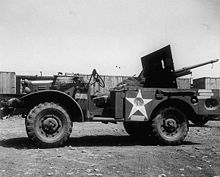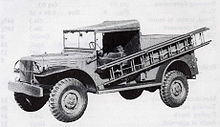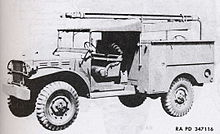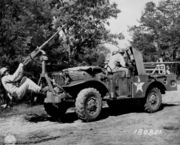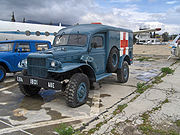- Dodge WC series
-
Dodge WC series 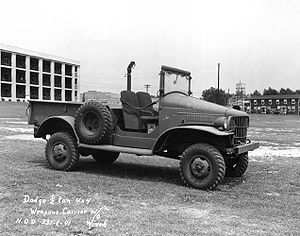
Manufacturer Dodge Production 1940–1945 Predecessor VC series Class Military vehicle Layout Front engine, four-wheel drive / six-wheel drive The Dodge WC series was a range of light military trucks produced by Dodge during World War II. The series included weapon carriers, telephone installation trucks, ambulances, reconnaissance vehicles, mobile workshops and command cars. They were replaced after the war by the Dodge M-series vehicles. WC was a Dodge model code: W for 1941 and C for half-ton rating. The C code was retained for the ¾ ton and 1½ ton 6×6 Dodges.[1]
Contents
History and design
Dodge began producing light trucks immediately upon its formation in 1914. For the first few years these were based largely on the existing passenger cars, later specific chassis and body designs were used. Light- and medium-duty models were offered first, then a heavy-duty range was added during the 1930s and 1940s. Dodge produced its first prototypes of dedicated military trucks in late 1939: the 1/2 ton 4x4 VC series. Production of the VC series started in 1940.[2] At the outset of World War II, Dodge produced the G-505 WC ½ ton series of military light trucks in 38 individual models, thousands of some models were produced, while only a few of some others were made. The WC ½ ton trucks replaced the 1940 VC-1 to VC-6 ½ton Dodge trucks which were also part of the G505 series. 79,771 of the ½ ton trucks were produced during late 1940–1942 under War Department contracts. WC models 1 to 50 were part of the 1/2 ton range and were 80% interchangeable in service parts with the later 3/4 ton models.[1]
Common features of the 1/2 ton trucks were:
- Drive: 4×4
- Wheelbase: 116 in (123 in for ambulances)
- Track width: 59.375 in
- Tires: 7.50x16
- Brakes: Hydraulic
- Engine: 6 cyl, in-line, L-head
- Transmission: 4 forward/1 reverse, manual
- Transfer case: Single speed
The Dodge G-502 ¾ ton 4×4 trucks were first introduced in late 1941. Standard vehicles in the ¾ ton 4×4 class were the WC-51 / WC-52 Weapons Carrier, Telephone Installation Trucks, WC-53 Carryall, and the WC-54 Ambulance. In the cargo trucks, the WC51 was identical to the WC52 but did not have the front bumper-mounted winch.[3]
Models
The table includes data on the relation between identification numbers and types of body fitted.[4] For comparison, earlier Dodge military trucks of the 1/2 ton range are included.
T202 T203 T207 T211 T214 T215 T112 T118 Pick-up (closed cab) VC3 VF401/VF402, VF404/VF405 WC1 WC12, WC14 WC40, WC25, WC47 WC38, WC47 Pick-up (open cab) VC5 WC3/WC4 WC13 WC51/WC52 WC21, WC22 Pick-up (no rear seats) VC4 WC5 Carry-all VC6 WC10 WC17 WC53 WC26, WC48 WC36, WC48 Dump truck VF403, VF406 Reconnaissance VC1 WC6/WC7 WC15 WC56/WC57 WC23/WC24 Radio truck VC2 WC8 WC16 WC58/WC64 WC54 WC25 Van WC11 WC19 WC42, WC49 WC37, WC49 Mobile workshop WC60 WC41 Maintenance WC60 WC43 Portee WC55 Ambulance VF407 WC9 WC18 WC54 WC27 Telephone line installation WC59 WC43 WC 39, WC50 Closed cab (without body) WC20 WC41 WF31 In the case of vehicle identifications separated by a slash, the first number refers to a vehicle not fitted with a winch, and the second to a vehicle fitted with a winch. Numbers separated by a comma indicate similar models but with different secondary details.
Engines
Vehicle code Bore (mm) Stroke (mm) Capacity (cm3) Compression ratio Torque (N m) Power (HP) T202 79.4 111.1 3294 6.7:1 208 79 T203 85.7 114.3 3957 6.5:1 255 99 T207 82.6 111.1 3567 6.5:1 222 78 T211 82.6 111.1 3567 6.5:1 222 78 T214 82.6 117.5 3772 6.7:1 244 92 T215 82.6 117.5 3772 6.7:1 249 99 T223 82.6 117.5 3772 6.7:1 244 92 Model descriptions
1/2 ton series
WC1, WC5, WC12, WC14, WC40
Closed cab, two seater pickups with a nominal carrying capacity of a 1,000 lb (450 kg).
WC3, WC13, WC21
Weapon carriers, two seater pickups with open cab. The open cab pickups could be fitted with an optional M24 machine gun mount,which bolted across the front of the bed. The mount could carry the M1918 Browning Automatic Rifle, as well as the M1919 Browning machine gun, and the M2 Browning machine gun.
- Length: 181- 1/16 inches
- Height: with top 88-1/8 inches
- Weight: 4440 net
- Width: 75-13/16 inches
- Height:
- Payload: 1300 LB
WC4, WC22
Open cab weapons carrier, with Braden MU winch, and transverse seats, designed to tow the M3 anti-tank cannon, as well as carry the gun crew, and ammunition. this type was usually issued to early tank destroyer units. 5570 built
- Length: 191- 5/16 inches
- Height: with top 88-1/8 inches
- Weight: 4775 net
- Width: 75-13/16 inches
- Height:
- Payload: 1000 LB
WC9, WC18, WC27
Entering production during 1941 to early 1942,[5] they were specifically designed to serve as military ambulances. These early variants are distinguishable from the later ones by having a curved radiator grille, while the later ones (WC51 onwards) featured a flat grille. These versions were given a longer 123 in (3,100 mm) wheelbase.
- Length: 195 inches
- Height: 90 inches
- Weight: 5340 net
- Width: 75-13/16 inches
- Height:
- Payload: 1300 LB
WC10, WC17, WC26, WC36, WC48
Carryall trucks with a nominal carrying capacity of a 1,000 lb (450 kg).
WC11, WC19, WC42
Panel trucks carrying radio and communication equipment, only built for export.
WC6, WC8, WC15, WC16, WC23, WC25
Command cars.
WC7, WC24
Command car with winch
WC39, WC43, WC50
These models were built as signals trucks, designed to install and repair telephone lines, and were also known by the U.S. Signals Corps as the K-50 truck.
WC41
Fitted with dual rear tires. Mostly employed as an emergency repair truck whose purpose was to provide mobile facilities for emergency ordnance repair. Other types of bodies were produced, such as an oil service vehicle. 902 of these chassis were built.
3/4 ton series
WC51
A winchless weapon carrier, 123 541 vehicles were built. The open cab pickups could be fitted with an optional M24A1 machine gun mount,which bolted across the front of the bed. The mount could carry the M1918 Browning Automatic Rifle, as well as the M1919 Browning machine gun, and the M2 Browning machine gun.
- Length: 4.24 m
- Height (with cover): 2.17 m
- Weight: 2 560 kg
- Width: 2.10 m
- Height (without cover): 1.71 m
- Payload: 800 kg
- WC52
Identical to the WC51, but fitted with a Braden MU-2 winch. (for transporting newer 57 mm Gun M1 antitank gun and crew)
- Length: 4,48 m
- Height with cover: 2,17 m
- Weight: 2 700 kg
- Width: 2,10 m
- Height without cover: 1,71 m
- Payload: 800 kg
WC53
A carryall, mechanically it was virtually identical to the WC54 but was fitted with two windows on each side of its rear body, 8 400 built.
- Length: 4,73 m
- Height: 2,06 m
- Weight: 2 590 kg
- Width: 2,00 m
- Payload: 800 kg
WC54
Main article: Dodge WC54The WC54 was mainly produced as an ambulance, but a few were modified to serve as radio/telephone trucks with the US Signal Corps.
- Length: 4,95 m
- Height: 2,30 m
- weight: 2 680 kg
- Width: 1,98 m
- Payload: 820 kg
WC55
The WC55, also known as the M6 Fargo, was an antitank GMC (Gun Motor Carriage) version equipped with a 37 mm cannon. 5380 built.
- Length: 4,25 m
- Height: 2,49 m
- Weight: 2 540 kg
- Width: 2,18 m
- Payload: 820 kg
WC56
A reconnaissance vehicle akin to a large Willys Jeep, it did not prove popular as it was heavier and not as maneuverable as the Jeep.
- Length: 4,22 m
- Height: 2,07 m
- Weight: 2 420 kg
- Width: 2,00 m
- Payload: 800 kg
WC57
A command car, identical to the WC56 but fitted with a winch. 6010 built.
- Length: 4,46 m
- Height: 2,07 m
- Weight: 2 560 kg
- Width: 2,00 m
- Payload: 800 kg
WC58
A command car, identical to the WC56 but fitted with a radio and 12-volt electrics. No winch was fitted.
- Length: 4.46 m
- Height: 2.07 m
- Weight: 2 420 kg
- Width: 2.00 m
- Payload: 800 kg
WC59
The WC59 was a signals truck, designed to install and repair telephone lines. Based on the same chassis as the WC54, but with a wheelbase increased by 50 cm. The spare wheel was carried behind the seats, with a step ladder fitted to where the spare wheel would have been. 549 were built. The bed was known by the Signal Corps as the K-50 truck, and was fitted to both Dodge and Chevrolet chassis.
- Length: 4,88 m
- Height: 2,06 m
- Weight: 2 430 kg
- Width: 1,98 m
- Payload: 800 kg
WC60
A mobile workshop designed for field maintenance, it featured the same body as the WC54 but with tool trunks that were accessible from the outside. 296 built.
- Length: 4.73 m
- Height: 2.26 m
- Weight: 2 700 kg
- Width: 2.08 m
- Payload: 800 kg
WC61
The WC61 was a signals truck, designed to install and repair telephone lines. Differently from the WC59, the step ladder was fitted to the roof. The spare wheel was fitted behind the seats, while the tool trunks were accessible from the outside. 58 built. The US Signal Corps referred to these as the K-50B truck.
- Length: 4,73 m
- Height (without ladder): 2,26 m
- Weight: 2 700 kg
- Width: 2,08 m
- Payload: 800 kg
WC62
A 6×6 weapons carrier, based on the WC51 but with a lengthened chassis and an extra axle added. 23092 built (WC62 and WC63 variants). One prototype produced as an armored car.[6]
- Length: 5.47 m
- Height (with cover): 2.17 m
- Weight: 3 120 kg
- Width: 2.10 m
- Height (without cover): 1.57 m
- Payload: 1500 kg
WC63
A 6×6 weapons carrier, based on the WC51 but with a lengthened chassis and an extra axle added. Identical to the WC62 but fitted with a winch.
- Length: 5,72 m
- Height (with cover): 2,17 m
- Weight: 3 250 kg
- Width: 2,10 m
- Height (without cover): 1,57 m
- Payload: 1500 kg
WC64
An ambulance based on the same chassis as the WC54 but with a knock-down body designed to increase the amount of vehicles that could be shipped at the same time. 3,500 were built between the beginning of 1945 and the end of the war.[7]
Former operators
- Austrian Army
- Used in Brazil by the Brazilian Army and in Europe by the Brazilian Expeditionary Force. Nicknamed Jipão.
- Greek Army and Greek Air Force
- Portuguese Army, redesignated Dodge m/48, used during the Portuguese Colonial War
- U.S Army, U.S. Army Medical Corps and U.S. Signal Corps
- Red Army by Lend-Lease during World War II
Gallery
-
French Army draisine, converted WC-51
See also
References
Some parts of this article are translated from French and Portuguese Wikipedia, tables are from Italian Wikipedia.
- Fred W. Crismon. US military wheeled vehicles. Victory WW2 Publishing Ltd. Minneapolis (MN-USA) (2001) ISBN 0-970056-71-0
- T. Richards and R.M. Clarke. Dodge WW2 military portfolio 1940-45. Brookland Books LTD (Surrey, UK) ISBN 1-85520-5535
- ^ a b http://www.olive-drab.com/idphoto/id_photos_dodge_g505_wc.php
- ^ http://www.dog-walker.us/4x4/4x4-204.htm
- ^ http://www.olive-drab.com/od_mvg_www_dodge.php3
- ^ T. Richards and R.M. Clarke, op. cit. pg 24-26
- ^ http://www.olive-drab.com/idphoto/id_photos_wc9.php
- ^ http://www.warwheels.net/FargoArmoredTruckINDEX.html
- ^ http://www.pinodesign.nl/dodge/history.htm
General references
- TM 9-2800 Standard Military Motor Vehicles. dated 1 sept. 1943
- TM 9-2800 Military vehicles dated oct. 1947
- TM 9-2800-1 Military vehicles dated 1953
- TM 9-808 http://www.ibiblio.org/hyperwar/USA/ref/TM/PDFs/TM_9_808.PDF
- SNL G657 Master Parts Book Dec. 1943
External links
- The WW2 Dodge Motor Pool
- Gordon's WW2 Army Trucks
- A WC-52 Restoration Project
- command-car.com - Dedicated to Dodge Command Car of WW2
- WC-4 towing M-3 37mm antitank cannon
- The Jeep Gets a Big Brother, November 1942, Popular Science early article introducing the American war public to the WC series
Dodge Current
productionCarsTrucks (Ram)Discontinued Cars024 · 330 · 400 · 600 · 880 · Aries · Aspen · Avenger · Brisa · Challenger · Charger (B-body) · Charger (L-body) · Charger Daytona · Colt · Conquest · Coronet · Custom 880 · Dart · Daytona · Demon · Diplomat · Dynasty · Intrepid · La Femme · Lancer · Matador · Mirada · Monaco · Neon · Omni · Phoenix · Polara · SE · Shadow · Sierra · Spirit · SRT-4 · St. Regis · Stealth · Stratus · Super BeeTrucks50 Series · 100 Series · 500 Series · A100 · B Series · C Series · D Series · Power Wagon · Rampage · Ram 50 · VC series · VF series · WC seriesCorporate Category:Dodge vehicles · Chrysler LLCCategories:- Dodge vehicles
- Military trucks
- Off-road vehicles
- Soft-skinned vehicles
- Military vehicles of the United States
- World War II military vehicles
- World War II vehicles of the United States
- Motor vehicles manufactured in the United States
Wikimedia Foundation. 2010.









